Firestorm Cloud
Beginning modestly in 1939 and developing into a billion dollar project employing more than 130,000 workers, the Manhattan Project of the United States, supported by Canada and Great Britain, under the direction of Major General Leslie Groves Jr. of the U.S. Army Corps of Engineers and the director of New Mexico's Los Alamos Laboratory, nuclear physicist Robert Oppenheimer, demonstrates the viability of nuclear fission in the top-secret Trinity Test that takes place in the Jornada del Muerto desert of New Mexico at 5:30 in the morning of July 16, 1945 (Oppenheimer will later say at the moment, he thinks of a part of the Hindu holy book, Bhagavad Gita, "Now I am become Death, the destroyer of worlds" ... the shock wave from the "gadget" that is detonated, equivalent to 20 kiltons of TNT going off, leaves a crater radioactive glass (Trinitite) 250 feet wide, is felt over 100 miles away, is heard as far away as El Paso, Texas, and produces a mushroom cloud that stretches 7.5 miles into the sky). Destructive capability confirmed, the components for what will come to be called the "Little Boy" bomb leave San Francisco's Hunters Point Naval Shipyard in California aboard the battleship USS Indianapolis on July 16, 1945 (in one of the many horrors of the war, the battleship will be torpedoed and sunk on the 30th, and in the sinking, subsequent exposure to the elements and shark attacks on the survivors, lose all but 316 members of its crew), and arrive on the Northern Mariana island of Tinian on July 26, 1945.


Oppenheimer & Groves
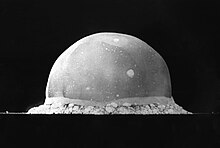
Milliseconds After Detonation

Dawn Of A New Age
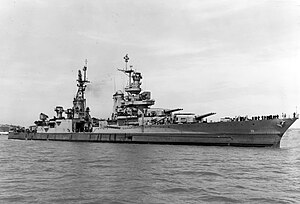
USS Indianapolis - July, 1945
Trained at Utah's Wendover Army Air Field specifically to deliver an atomic weapon, waiting on the island of Tinian (the island is taken in a week of fighting by the 2nd and 4th Marine Divisions, and the 147th Infantry Regiment that ends on August 1, 1944) by are ground and flight personnel of the 509th Composite Group, over 1,500 officers, enlisted men, a handful of civilians, and fifteen Silverplate B-29 Superfortresses, specially modified with fuel-injected engines, Curtiss Electric reversible-pitch propellers, and pneumatic actuators for the bomb bay doors to allow the carrying of nuclear weapons. In command of flight operations is thirty-year-old Colonel Paul Warfield Tibbets Jr., a Midwesterner from Des Moines, Iowa who gets his first taste of flying at carnival in 1927 at the age of twelve, compliments of his mother, Enola Gay, paying one dollar to barnstormer Doug Davis to take the youth up (the pair drop candy bars in parachutes on the people attending the races at the nearby Hialeah Park Race Track). Intelligent, Tibbets first studies to be abdominal surgeon at the University of Florida and then University of Cincinnati, but in 1937 decides instead that he wants to be a pilot in the United States Army Air Force. By 1938 he is an above-average pilot and 2nd Lieutenant (he marries and has two children). Ladder upward to destiny, he serves as the personal pilot for Brigadier General George S. Patton (1940-1941), flies an A-20 Havoc, trains in B-17 Flying Fortresses, flies anti-submarine patrols in a B-18 Bolo medium bomber, flies the lead bomber on the Eight Air Force's first raid over Europe in August of 1942, leads to first mission of more than 100 American bombers, and after Major General Carl Spaatz is asked to select his two best pilots for a special assignment, flies Supreme Allied Commander, Lt. General Dwight D. Eisenhower about during the invasion of North Africa (along with Major General Mark Clark). Transferred to the bombers of Major General Jimmy Doolittle's Twelfth Air Force in North Africa, he moves on to the new B-29 Superfortress program in 1943 after clashing with Doolittle's Chief of Staff and assistant operations officer, Brigadier General Hoyt Vandenburg and Colonel Lauris Norstad. In no time at all, Tibbets amasses more flight time in the B-29 bomber than any pilot in the Army Air Force and by 1945 is ready for his next special assignment.
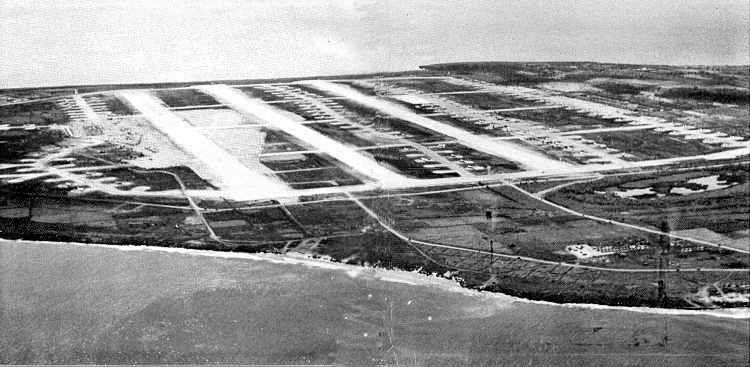
North Field - Tinian
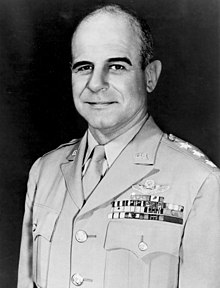

Doolittle & Spaatz
Tibbets
Unconditional surrender refused by Imperial Japan, leaflets dropped warning the civilian population that something big is coming to the cities of Japan (in the months before Hiroshima is bombed, 63 million are leaflets are dropped on Japan), bomb ready (fearing a crash could set it off, it will not be armed until the Enola Gay is in the air, the mission that will open a new era in the history of mankind begins when Tibbets takes off in the early morning hours of Monday, August 6, 1945. With Tibbets piloting, aboard the Superfortress are Captain Robert A. Lewis (co-pilot), Major Thomas Ferebee (Bombadier), Captain Theodore "Dutch" Van Kirk, Navy Captain William S. Parsons (responsible for arming the bomb), First Lieutenant Jacob Beser (radar countermeasures, he will be the only man to fly in both the planes that drop atomic weapons), Second Lieutenant Morris R. Jepperson (assistant weaponeer), Staff Sergeant George R. "Bob" Caron (tail gunner), Staff Sergeant Wyatt E. Duzenbury (flight engineer), Sergeant Joe S. Stiborik (radio operator), Sergeant Robert H. Shumard (assistant flight engineer), and Private First Class Richard H. Nelson (VHF radio operator) ... also aboard is Little Boy, a 10-foot long, 28-inch diameter, gun-type nuclear fission bomb wearing 9,700 pounds filled with 140 pounds of Uranium-235. The flight is six hours away from the target that has been selected, the supply and logistics military-industrial port city of Hiroshima, the second largest city in Japan as yet undamaged by American bombing raids (also along on the mission are six other B29s, Straight Flush, Jabit III, Full House, The Great Artiste, Necessary Evil, and Top Secret, responsible for providing backup, weather reconnaissance, blast measurement data, strike observation, and photography).

Order For The Drop

L To R - Big Stink, The Great Artiste, Enola Gay

Tibbets Waving Before Take Off

Ready To Load
Hiroshima
Airborne, weaponeer Parsons and his assistant Jeppson, make their way over a narrow catwalk on the port side of the B29's bomb bay to Little Boy. There, while Jeppson holds a flashlight, Parsons disconnects the primer wires, removes the breech plug, inserts the bomb's powder bags, replaces the breech plug, and reconnects the primer wires. Almost ready, thirty minutes away, when the Enola Gay approaches the target area and begins to climb to its drop altitude, Jeppson switches the three safety plugs between the electrical connectors of the device's internal battery and it's firing mechanism from green to red ... the bomb is now fully armed. 31,000 feet over the target city, at approximately 8:15 in the morning, with Bombardier Ferebee flying, Little Boy, bearing the inscription "Greetings to the Emperor from the men of the USS Indianapolis" (Yikes, can you say BAD KHARMA!) is released and begins a fall of 44.4 seconds. It explodes 1,968 feet over the city of 330,000 souls.

Arming Plugs

Bombardier Ferebee And His Norden Bombsight

Explosion Cloud

Two To Five Minutes After Detonation
Unleashing in a microsecond the equivalent of 12,500 tons of TNT, a burst of blinding light is followed by a fireball 1,200 feet in diameter, with a surface temperature of 6,000 degrees (one unknown victim sitting on stone steps 850 feet away from the center of the explosion leaves only his shadow to note his passing) that sucks air from the area and ignites everything flammable, a firestorm two miles in diameter that only ends when it runs out of fuel hours later. The atomic detonation destroys 62,000 of Hiroshima's 90,000 buildings (except for fifty heavily reinforced concrete structures, of which only their shells remain, everything within a mile radius directly under the point of detonation is totally destroyed), kills approximately 80,000 people (an exact toll will never be arrived at as many of the casualties simply vanish, along with all paper documentation of their very existence), 20,000 of whom are soldiers, with another 60,000 perishing by the end of the year due to their burns, wounds and exposure to neutron and gamma rays ... additionally, 35,000 citizens are injured in the blast (treatment of the sick and dying is extremely hindered as only 20 of the city's 200 doctors survive the explosion, a toll duplicated in the attrition that takes place to Hiroshima's nurses, of which only 150 remain of 1,780). It is devastation on a horrific level!
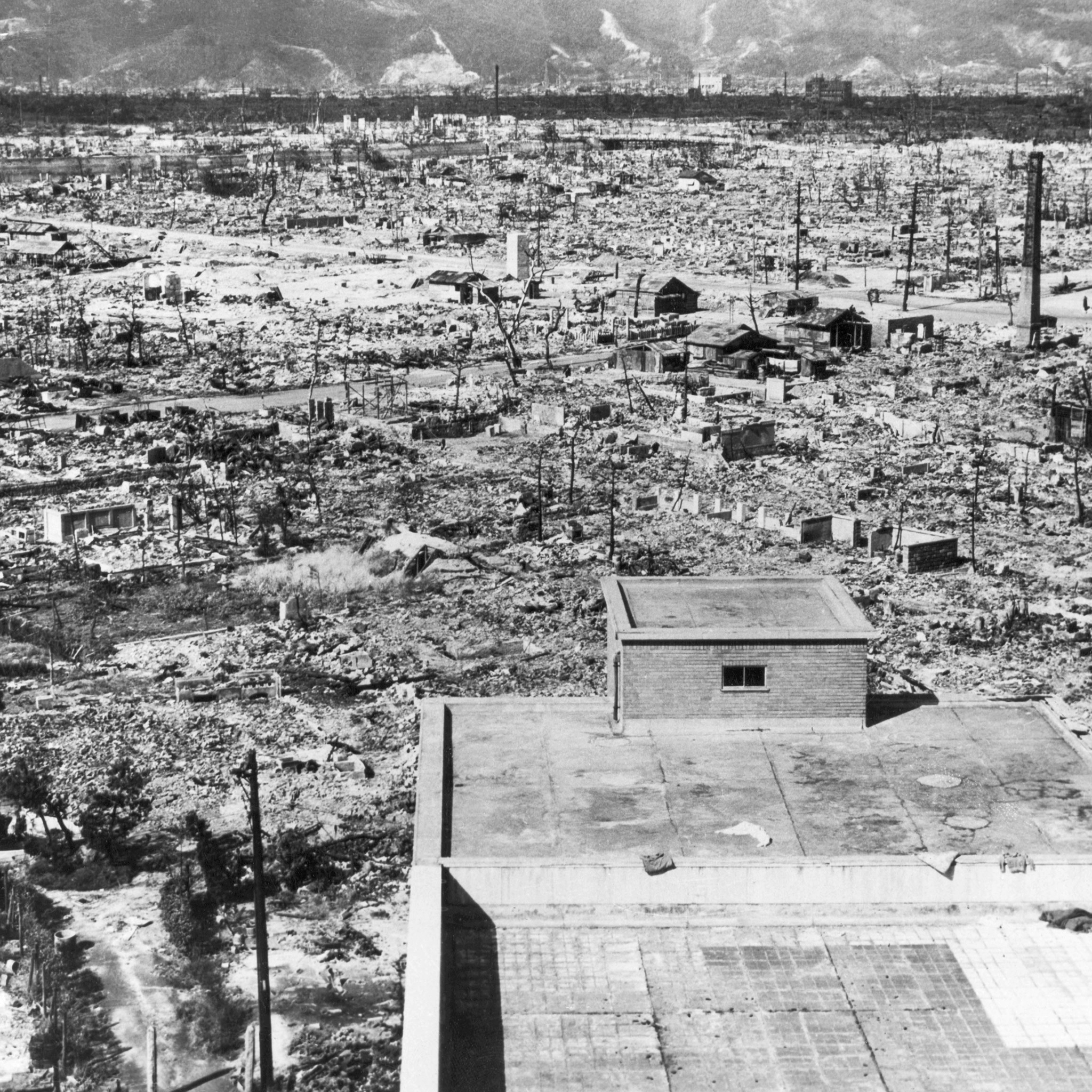
After

Wreckage

Victims
The Enola Gay is 11.5 miles away from the blast when it feels the shock waves of the detonation it has caused, but is undamaged. Returning to Tinian, in front of hundreds of service men, photographers, and journalists, all now aware that a special mission has taken place, Tibbets and his crew touch down at 2:58 in the afternoon, after a mission flight that has lasted 12 hours and 13 minutes. First out of the plane, Tibbets is immediately awarded the Distinguished Service Cross by General Carl Spaatz, overall commander of air operations in the Pacific (Tibbets will serve in the Air Force until 1966 and retires as a Brigadier General ... he dies of heart failure in his Columbus, Ohio home in November of 2007 at the age of 92). Sadly for the Japanese, the message to quit fighting is not received, and unconditional surrender refused again, a second nuclear bomb will be dropped on the city of Nagasaki (the Enola Gay, with another crew, flies weather reconnaissance for the mission ... the legendary B-29 is now on display at the Smithsonian's National Air & Space Museum in Washington D.C.) before Japan surrenders and the war ends with the signing of formal documents in Tokyo Bay, aboard the battleship USS Missouri, on September 2, 1945.

Landing

Award Ceremony
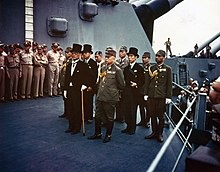
Surrender

On Display
No comments:
Post a Comment